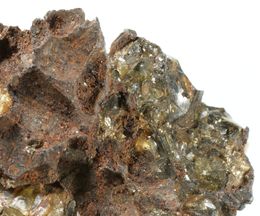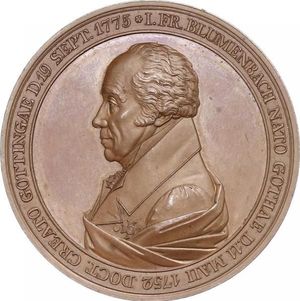|
Education and career
Blumenbach and Göttingen
Academy of Sciences
Scientific collections
Biographical literature
Biographical data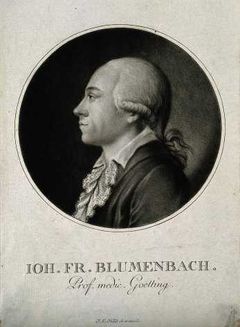
J. F. Blumenbach. Mezzotint by Johann Elias Haid. Credit: Wellcome Collection, licence CC BY 4.0 Earliest known portrait of Blumenbach. Click to enlarge. |
|
| Johann Friedrich Blumenbach (May 11, 1752–January 22, 1840) came from a well-to-do family of academics and civil servants in Gotha, the capital of the small German duchy of Saxe-Gotha-Altenburg. His father, Johann Heinrich Blumenbach (1709–1787), was a professor at the Gotha grammar school, the Gymnasium illustre, and its prorector; his mother, Charlotte Eleonore Hedwig Blumenbach (1727–1794), was the daughter of Karl Franz Buddeus (1695–1753), vice-chancellor of the government of Saxe-Gotha, and the granddaughter of the Jena professor of theology Johann Franz Buddeus (1667–1729). Blumenbach had a sister (Charlotte Sophie Henriette, died 1802) and a brother (Friedrich Wilhelm Carl Ernst, died 1806). There were also family ties to another dynasty of scholars at Jena, the Walch family: Johann Georg Walch (1693–1775), a professor of theology at Jena, was the brother-in-law of Blumenbach’s maternal grandfather and therefore Blumenbach’s great-uncle. One of his sons, Johann Ernst Immanuel Walch (1725–1778), was Blumenbach’s teacher in natural history at Jena University, and another son, Christian Wilhelm Franz Walch (1726–1784), became professor of theology at Göttingen University in 1754. |
| Blumenbach retained his close connection with Gotha in later life. He stayed there for fairly long visits once or twice a year and on these occasions was invited to the duke’s court. He corresponded with several members of the ducal family and with Gotha scientists, especially Franz Xaver von Zach, and contributed to scientific journals published there and to the Almanach de Gotha (Gothaischer Hofkalender). Toward the end of 1814, a breakup with the new duke of Gotha, August, occurred. Two years later, Blumenbach bought the house in Göttingen where he had been living since 1784 – an investment that involved the acquisition of the town’s citizenship. |
| In 1779 Blumenbach married Louise Amalie Brandes (1752–1837), thus establishing family relations with influential circles at Göttingen University and in the administration of the Electorate of Hanover, the territory to which Göttingen belonged. Her father was Georg Friedrich Brandes (1709–1791), the Hanoverian state secretary for university affairs. Louise Amalie was also the sister-in-law of the classical scholar Christian Gottlob Heyne (1729–1812), the central figure of the academic scene at Göttingen, given his influence as director of the University Library and secretary of the Academy of Sciences. |
|
|

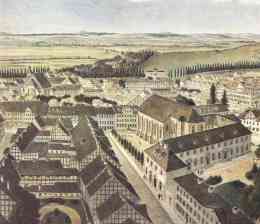
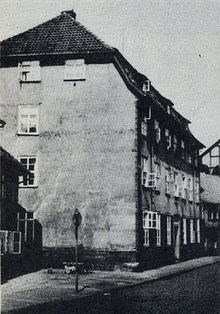 Blumenbach’s home in Göttingen. Historical photograph from D. Koch: Das Göttinger Honoratiorentum vom 17. bis zur Mitte des 19. Jahrhunderts. Göttingen: Vandenhoeck and Ruprecht, 1958, table VIII. The Göttingen naturalist Johann Christian Polycarp Erxleben (1744–1777) lived in this house since 1774. Blumenbach moved into this house in 1784 and bought it in 1816. The present-day name of the street is “Neustadt.” The historical buildings of this part of the town, including Blumenbach’s house, were demolished around 1970.
Blumenbach’s home in Göttingen. Historical photograph from D. Koch: Das Göttinger Honoratiorentum vom 17. bis zur Mitte des 19. Jahrhunderts. Göttingen: Vandenhoeck and Ruprecht, 1958, table VIII. The Göttingen naturalist Johann Christian Polycarp Erxleben (1744–1777) lived in this house since 1774. Blumenbach moved into this house in 1784 and bought it in 1816. The present-day name of the street is “Neustadt.” The historical buildings of this part of the town, including Blumenbach’s house, were demolished around 1970.
